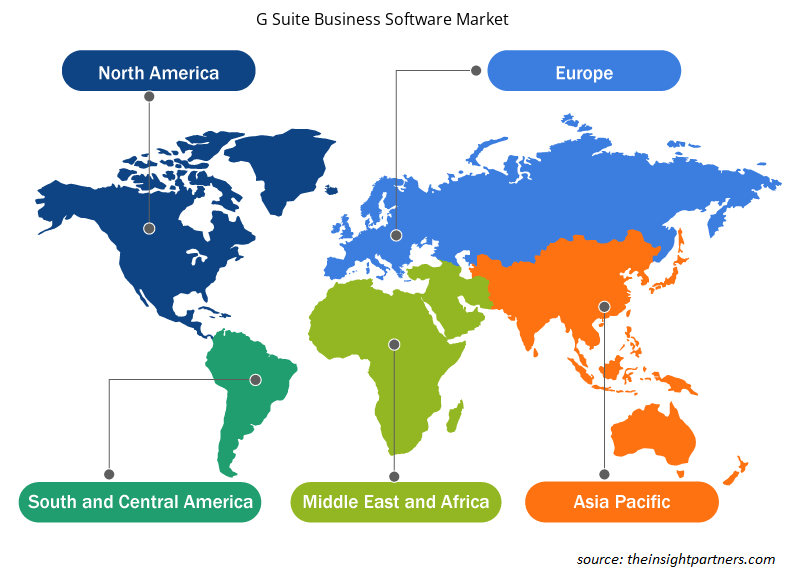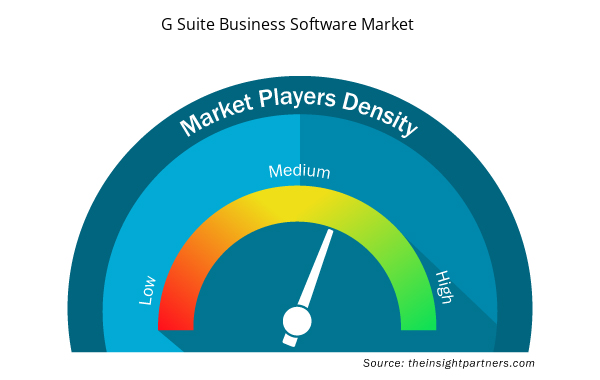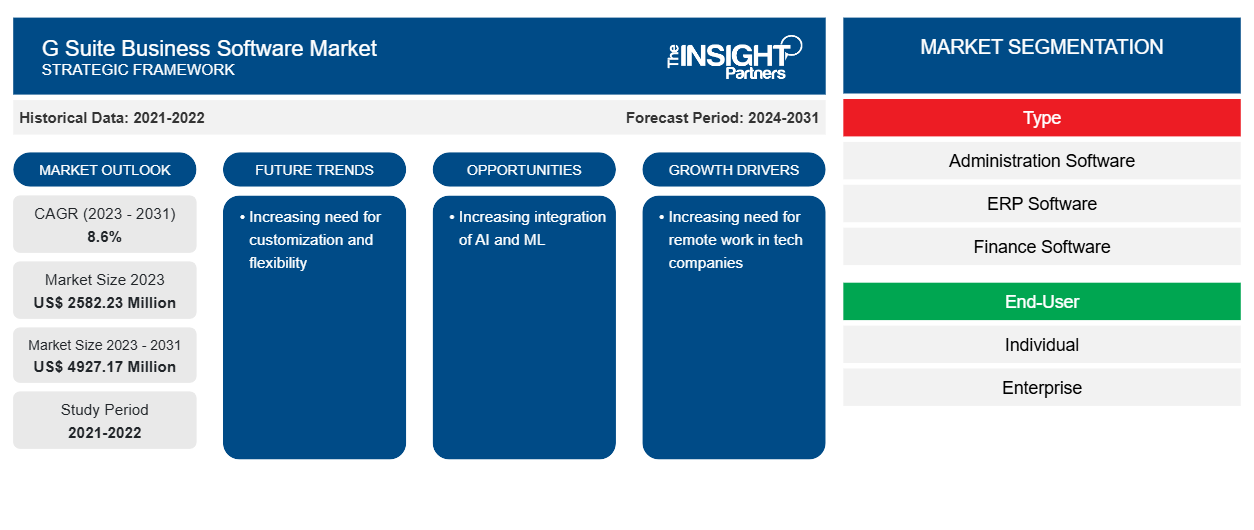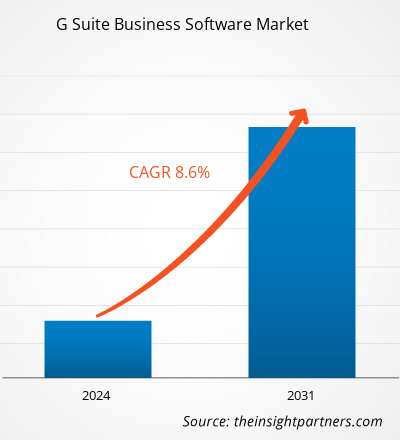Se proyecta que el tamaño del mercado de software empresarial G Suite alcance los 4927,17 millones de dólares en 2031, frente a los 2582,23 millones de dólares en 2023. Se espera que el mercado registre una CAGR del 8,6 % durante el período 2023-2031. Es probable que la creciente necesidad de personalización y flexibilidad siga siendo una tendencia clave en el mercado.CAGR of 8.6% during 2023–2031. The increasing need for customization and flexibility is likely to remain a key trend in the market.
Análisis del mercado del software empresarial G Suite
G Suite permite a las empresas y organizaciones utilizar el conjunto de herramientas de colaboración y productividad basadas en la nube de Google al final de sus procesos comerciales. Varios desarrolladores y proveedores de soluciones externos ofrecen una gestión y gobernanza superiores de las soluciones de G Suite en función de los requisitos de las empresas. Calendly ofrece una solución para G Suite que funciona a la perfección con Google Calendar para administrar todas las reservas y actividades relacionadas con la programación. Mixmax ofrece soluciones de calendario y una plataforma de productividad de correo electrónico para ventas, éxito del cliente, contratación, operaciones de ventas, liderazgo y emprendedores. Las empresas externas proporcionan herramientas adicionales para G Suite que mejoran la productividad y la capacidad de gestión de las empresas y brindan a los clientes requisitos personalizados.
Descripción general del mercado del software empresarial G Suite
G Suite es un conjunto de aplicaciones de software como servicio (SaaS) diseñado y desarrollado por Google. Estas aplicaciones basadas en la nube se centran en diferentes áreas, como los negocios, la colaboración, la productividad y la educación. Gmail, Docs, Sheets, Drive, Calendar, Google+, Slides, Forms, Sites, Hangouts y Keep son las principales herramientas de G Suite disponibles por Google. G Suite es un recurso valioso tanto para empresas como para particulares de todo el mundo.
Personalice este informe según sus necesidades
Obtendrá personalización en cualquier informe, sin cargo, incluidas partes de este informe o análisis a nivel de país, paquete de datos de Excel, así como también grandes ofertas y descuentos para empresas emergentes y universidades.
- Obtenga las principales tendencias clave del mercado de este informe.Esta muestra GRATUITA incluirá análisis de datos, desde tendencias del mercado hasta estimaciones y pronósticos.
Impulsores y oportunidades del mercado del software empresarial G Suite
Creciente necesidad de trabajo remoto en empresas tecnológicas
Los empleadores están cada vez más interesados en puestos en empresas que ofrecen modelos de trabajo remoto o híbrido, y cada vez más empleadores reconocen esta tendencia. De 2021 a 2022, un informe del sitio web de anuncios de empleo FlexJobs.com reveló que los anuncios de puestos remotos aumentaron del 12 % el año anterior al 12 %. La popularidad del trabajo remoto se ha convertido en un factor importante y es probable que aumente a medida que los empleadores refinen sus políticas de empleo sobre el trabajo desde casa. Por lo tanto, la creciente necesidad de trabajo remoto en las empresas de tecnología está impulsando el mercado de software empresarial G Suite.FlexJobs.com revealed that listings for remote positions rose from 12% the previous year to 12%. The popularity of remote work has become a major factor and is likely to rise as employers refine their employment policies on working from home. Therefore, the increasing pen need for remote work in tech companies is driving the G suite business software market.
Aumento de la integración de la IA
Con la ayuda de la IA y el ML, G Suite añade herramientas de seguridad. Varias empresas están implementando el software empresarial de G Suite con tecnologías de IA y ML. Por ejemplo, en 2020, el gigante de las búsquedas anunció varias actualizaciones de G Suite mediante el uso de IA, su conjunto de aplicaciones que se parecen a Google Docs y Sheets pero están diseñadas para la oficina. La empresa anunció esto durante su conferencia anual Google Cloud Next en San Francisco. Por lo tanto, la creciente integración de la IA con el software empresarial de G Suite está creando más oportunidades para el mercado.deployoing G suite business software with AI and ML technologies. For instance, in 2020, the search giant announced several updates to G Suite by using AI, its set of apps that resemble Google Docs and Sheets but are tailored for the office. The company announced this during its annual Google Cloud Next conference in San Francisco. Therefore, the increasing integration of AI with G Suite business software is creating more opportunities for the market.
Informe de análisis de segmentación del mercado de software empresarial G Suite
Los segmentos clave que contribuyeron a la derivación del análisis del mercado del software empresarial G Suite son el tipo y el usuario final.
- Según el tipo, el mercado de software empresarial de G Suite se divide en software de administración, software ERP, software financiero, software de RR.HH. y otros. El segmento personalizado tuvo una mayor participación de mercado en 2023.ERP software, finance software, HR software, and others. The customized segment held a larger market share in 2023.
- Por usuarios finales, el mercado se segmenta en individuos, empresas y otros.
Análisis de la cuota de mercado del software empresarial G Suite por geografía
El alcance geográfico del informe de mercado de software empresarial G Suite se divide principalmente en cinco regiones: América del Norte, Asia Pacífico, Europa, Medio Oriente y África, y América del Sur y Central.
La región APAC domina el mercado de software empresarial G Suite. El mercado de software empresarial G Suite en esta región está creciendo debido a diversos factores, como el aumento de las iniciativas de las organizaciones para mejorar su seguridad y la presencia de proveedores dominates the G Suite business software market. The G suite business software market in this region is growing due to various factors, such as increasing organizations' initiatives to improve their security and the presence of well-established G suite business de software empresarial G Suite bien establecidos .
Perspectivas regionales del mercado del software empresarial G Suite
Los analistas de Insight Partners explicaron en detalle las tendencias y los factores regionales que influyen en el mercado de software empresarial G Suite durante el período de pronóstico. Esta sección también analiza los segmentos y la geografía del mercado de software empresarial G Suite en América del Norte, Europa, Asia Pacífico, Oriente Medio y África, y América del Sur y Central.

- Obtenga datos regionales específicos para el mercado de software empresarial G Suite
Alcance del informe de mercado del software empresarial G Suite
| Atributo del informe | Detalles |
|---|---|
| Tamaño del mercado en 2023 | US$ 2582,23 millones |
| Tamaño del mercado en 2031 | US$ 4927,17 millones |
| CAGR global (2023 - 2031) | 8,6% |
| Datos históricos | 2021-2022 |
| Período de pronóstico | 2024-2031 |
| Segmentos cubiertos | Por tipo
|
| Regiones y países cubiertos | América del norte
|
| Líderes del mercado y perfiles de empresas clave |
|
Densidad de actores del mercado del software empresarial G Suite: comprensión de su impacto en la dinámica empresarial
El mercado de software empresarial G Suite está creciendo rápidamente, impulsado por la creciente demanda de los usuarios finales debido a factores como la evolución de las preferencias de los consumidores, los avances tecnológicos y una mayor conciencia de los beneficios del producto. A medida que aumenta la demanda, las empresas amplían sus ofertas, innovan para satisfacer las necesidades de los consumidores y aprovechan las tendencias emergentes, lo que impulsa aún más el crecimiento del mercado.
La densidad de actores del mercado se refiere a la distribución de las empresas o firmas que operan dentro de un mercado o industria en particular. Indica cuántos competidores (actores del mercado) están presentes en un espacio de mercado determinado en relación con su tamaño o valor total de mercado.
Las principales empresas que operan en el mercado de software empresarial G Suite son:
- RANURA
- MAILTRACK.IO
- Calendario
- Compañía NetHunt Inc.
- Mixmax
- Salesforce.com inc.
Descargo de responsabilidad : Las empresas enumeradas anteriormente no están clasificadas en ningún orden particular.

- Obtenga una descripción general de los principales actores clave del mercado de software empresarial de G Suite
Noticias y novedades del mercado del software empresarial G Suite
El mercado del software empresarial G Suite se evalúa mediante la recopilación de datos cualitativos y cuantitativos a partir de una investigación primaria y secundaria, que incluye publicaciones corporativas importantes, datos de asociaciones y bases de datos. A continuación, se enumeran algunos de los avances en el mercado del software empresarial G Suite:
- Google rebautizó G Suite, un conjunto de herramientas de colaboración y productividad en línea para empresas que incluye Gmail, Drive, Docs y Meet. El nuevo nombre es Google Workspace, un nombre que la empresa ya había insinuado cuando presentó por primera vez un conjunto de nuevas herramientas de colaboración e integraciones de Google Meet para el servicio a principios de este año. (Fuente: Google, comunicado de prensa, octubre de 2020)
- G Suite de Google incorporó nuevas herramientas de inteligencia artificial y seguridad. El gigante de las búsquedas anunció varias actualizaciones para G Suite, su conjunto de aplicaciones que se asemejan a Google Docs y Sheets, pero están diseñadas para la oficina. (Fuente: Tungsram Group, comunicado de prensa, julio de 2021)
Informe sobre el mercado de software empresarial G Suite: cobertura y resultados
El informe “Tamaño y pronóstico del mercado del software empresarial G Suite (2021-2031)” proporciona un análisis detallado del mercado que cubre las siguientes áreas:
- Tamaño del mercado del software empresarial G Suite y pronóstico a nivel global, regional y nacional para todos los segmentos clave del mercado cubiertos bajo el alcance
- Tendencias del mercado del software empresarial G Suite, así como dinámicas del mercado, como impulsores, restricciones y oportunidades clave
- Análisis detallado de las cinco fuerzas de Porter y PEST y FODA
- Análisis del mercado del software empresarial G Suite que abarca las tendencias clave del mercado, el marco global y regional, los principales actores, las regulaciones y los desarrollos recientes del mercado
- Análisis del panorama de la industria y de la competencia que abarca la concentración del mercado, el análisis de mapas de calor, los actores destacados y los desarrollos recientes del mercado de software empresarial G Suite
- Perfiles detallados de empresas
- Análisis histórico (2 años), año base, pronóstico (7 años) con CAGR
- Análisis PEST y FODA
- Tamaño del mercado Valor/volumen: global, regional, nacional
- Industria y panorama competitivo
- Conjunto de datos de Excel



Report Coverage
Revenue forecast, Company Analysis, Industry landscape, Growth factors, and Trends

Segment Covered
This text is related
to segments covered.

Regional Scope
North America, Europe, Asia Pacific, Middle East & Africa, South & Central America

Country Scope
This text is related
to country scope.
Preguntas frecuentes
The expected CAGR of the global G suite business software market is 8.6%.
The global G suite business software market is expected to reach US$ 4927.17 million by 2031.
The key players holding majority shares in the global G suite business software market are GROOVE, MAILTRACK.IO, Calendly, NetHunt Inc., Mixmax, Salesforce.com, inc., Rewardly, Inc, Zendesk, Expensify, Inc., and Freshworks Inc.
The increasing need for customization and flexibility is anticipated to play a significant role in the global G suite business software market in the coming years.
The increasing need for remote work in tech companies and the increasing integration of AI and ML are the major factors that propel the global G suite business software market.
Europe dominates the G suite business software market.
Trends and growth analysis reports related to Technology, Media and Telecommunications : READ MORE..
The Insight Partners performs research in 4 major stages: Data Collection & Secondary Research, Primary Research, Data Analysis and Data Triangulation & Final Review.
- Data Collection and Secondary Research:
As a market research and consulting firm operating from a decade, we have published and advised several client across the globe. First step for any study will start with an assessment of currently available data and insights from existing reports. Further, historical and current market information is collected from Investor Presentations, Annual Reports, SEC Filings, etc., and other information related to company’s performance and market positioning are gathered from Paid Databases (Factiva, Hoovers, and Reuters) and various other publications available in public domain.
Several associations trade associates, technical forums, institutes, societies and organization are accessed to gain technical as well as market related insights through their publications such as research papers, blogs and press releases related to the studies are referred to get cues about the market. Further, white papers, journals, magazines, and other news articles published in last 3 years are scrutinized and analyzed to understand the current market trends.
- Primary Research:
The primarily interview analysis comprise of data obtained from industry participants interview and answers to survey questions gathered by in-house primary team.
For primary research, interviews are conducted with industry experts/CEOs/Marketing Managers/VPs/Subject Matter Experts from both demand and supply side to get a 360-degree view of the market. The primary team conducts several interviews based on the complexity of the markets to understand the various market trends and dynamics which makes research more credible and precise.
A typical research interview fulfils the following functions:
- Provides first-hand information on the market size, market trends, growth trends, competitive landscape, and outlook
- Validates and strengthens in-house secondary research findings
- Develops the analysis team’s expertise and market understanding
Primary research involves email interactions and telephone interviews for each market, category, segment, and sub-segment across geographies. The participants who typically take part in such a process include, but are not limited to:
- Industry participants: VPs, business development managers, market intelligence managers and national sales managers
- Outside experts: Valuation experts, research analysts and key opinion leaders specializing in the electronics and semiconductor industry.
Below is the breakup of our primary respondents by company, designation, and region:

Once we receive the confirmation from primary research sources or primary respondents, we finalize the base year market estimation and forecast the data as per the macroeconomic and microeconomic factors assessed during data collection.
- Data Analysis:
Once data is validated through both secondary as well as primary respondents, we finalize the market estimations by hypothesis formulation and factor analysis at regional and country level.
- Macro-Economic Factor Analysis:
We analyse macroeconomic indicators such the gross domestic product (GDP), increase in the demand for goods and services across industries, technological advancement, regional economic growth, governmental policies, the influence of COVID-19, PEST analysis, and other aspects. This analysis aids in setting benchmarks for various nations/regions and approximating market splits. Additionally, the general trend of the aforementioned components aid in determining the market's development possibilities.
- Country Level Data:
Various factors that are especially aligned to the country are taken into account to determine the market size for a certain area and country, including the presence of vendors, such as headquarters and offices, the country's GDP, demand patterns, and industry growth. To comprehend the market dynamics for the nation, a number of growth variables, inhibitors, application areas, and current market trends are researched. The aforementioned elements aid in determining the country's overall market's growth potential.
- Company Profile:
The “Table of Contents” is formulated by listing and analyzing more than 25 - 30 companies operating in the market ecosystem across geographies. However, we profile only 10 companies as a standard practice in our syndicate reports. These 10 companies comprise leading, emerging, and regional players. Nonetheless, our analysis is not restricted to the 10 listed companies, we also analyze other companies present in the market to develop a holistic view and understand the prevailing trends. The “Company Profiles” section in the report covers key facts, business description, products & services, financial information, SWOT analysis, and key developments. The financial information presented is extracted from the annual reports and official documents of the publicly listed companies. Upon collecting the information for the sections of respective companies, we verify them via various primary sources and then compile the data in respective company profiles. The company level information helps us in deriving the base number as well as in forecasting the market size.
- Developing Base Number:
Aggregation of sales statistics (2020-2022) and macro-economic factor, and other secondary and primary research insights are utilized to arrive at base number and related market shares for 2022. The data gaps are identified in this step and relevant market data is analyzed, collected from paid primary interviews or databases. On finalizing the base year market size, forecasts are developed on the basis of macro-economic, industry and market growth factors and company level analysis.
- Data Triangulation and Final Review:
The market findings and base year market size calculations are validated from supply as well as demand side. Demand side validations are based on macro-economic factor analysis and benchmarks for respective regions and countries. In case of supply side validations, revenues of major companies are estimated (in case not available) based on industry benchmark, approximate number of employees, product portfolio, and primary interviews revenues are gathered. Further revenue from target product/service segment is assessed to avoid overshooting of market statistics. In case of heavy deviations between supply and demand side values, all thes steps are repeated to achieve synchronization.
We follow an iterative model, wherein we share our research findings with Subject Matter Experts (SME’s) and Key Opinion Leaders (KOLs) until consensus view of the market is not formulated – this model negates any drastic deviation in the opinions of experts. Only validated and universally acceptable research findings are quoted in our reports.
We have important check points that we use to validate our research findings – which we call – data triangulation, where we validate the information, we generate from secondary sources with primary interviews and then we re-validate with our internal data bases and Subject matter experts. This comprehensive model enables us to deliver high quality, reliable data in shortest possible time.


 Obtenga una muestra gratuita de este informe
Obtenga una muestra gratuita de este informe